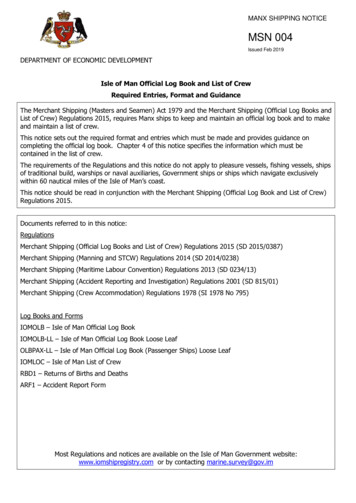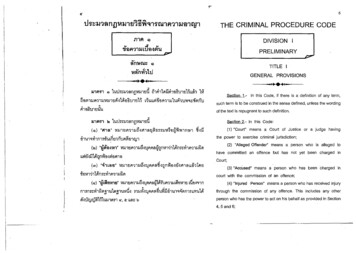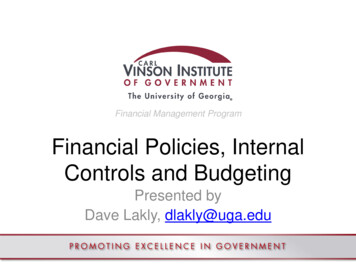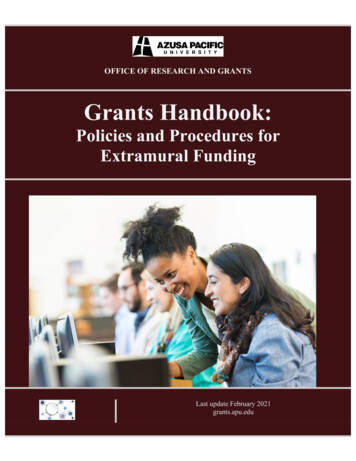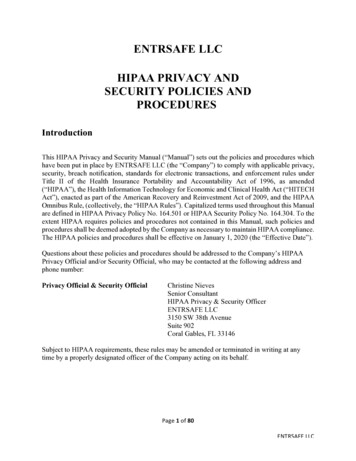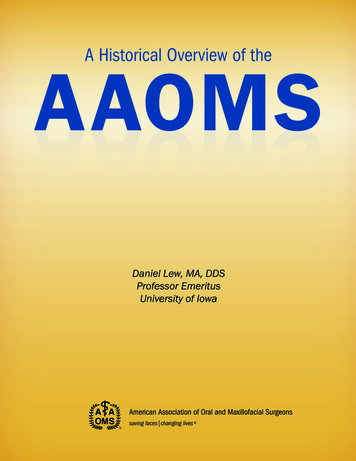
Transcription
The opinions and statements expressed in the history essay are solely those of the author and do not necessarily representthe official policies or history of the AAOMS. The AAOMS does not warrant this work for accuracy or for any purpose other thana historical perspective. Copyright 2013 by the American Association of Oral and Maxillofacial SurgeonsAll Rights Reserved.No part of this publication may be reproduced, stored in a retrieval system, or transmitted in any form or by any means —electronic, mechanical, photocopying, recording or otherwise without the prior written permission of the American Associationof Oral and Maxillofacial Surgeons.
A Historical Overview of theAAOMSDaniel Lew, MA, DDSProfessor EmeritusUniversity of Iowa
ii
DEDICATIONRobert V. Walker, DDS(1925 – 2011)Pioneer, educator, founder, mentor, role model, lecturer,golfer, deacon, historian, innovator — words alone cannotdescribe the many contributions to the specialty of oral andmaxillofacial surgery provided by Dr. Robert V. (RV)Walker. He was a giant of his time and all of us in thespecialty are the better for it. We humbly dedicate thisupdate of the history of the specialty to our friend, colleagueand most valued member of the Advisory Committee onAAOMS History and Archives, and thereby honor himfor the many blessings and good fortune of his life.iii
PREFACEThis essay on the history of the American Association of Oral and Maxillofacial Surgeons(AAOMS) will attempt to identify the seminal social, economic and political currents thathave coursed, often repeatedly, through our history. It is hoped that this effort will helpthe deliberations of those who in the future participate in and direct the affairs of the specialty.In structuring this essay I was influenced by Lord Acton’s dictum “Take up a problem and nota period.” Problems do not have timelines and are not isolated entities. Some cannot be solved,some are ignored and some are not well solved. All of these bring about their recurrence andtherein the reasons for their study. Social historical analysis is also a chronicle of human actions,motives and personalities. These form the fibers that knit together the tapestry of events. Thespecialty, in a previous publication, duly recognized the contributions of our founders and theirsuccessors.There were major currents and decisions that defined our existence. The establishment of privatepractice and academia are described in separate chapters, as their early development, of necessity,required the development of a political and economic base prior to the creation of academia.From the inception, they reflected the existing medical structure of clinical care and education.The hospital is the entity that courses through this essay, as it traces the decline of its influenceon our affairs. It was for us, symbolically and practically, the site where we entered the nation’shealthcare system after fighting epic national and local battles with organized medicine. It wasalso the center where academia and private practice played out their multiple roles of teaching,research and clinical service.The influence of fluoridation, the American Dental Association’s (ADA) decision not toparticipate in Medicare and osseointegration profoundly altered the scope and composition of thespecialty. These are discussed separately, but their convergence continues to shape the economicsand character of the specialty. These decisions have also altered our relations with the ADA andother dental specialties, as some of these were facing existential problems.iv
Part of this essay considers how governmental policies and the growing influence of insurancecarriers on the healthcare system have stimulated centralization of care and practice. Federal andstate governments have been searching for ways to deliver healthcare to a larger population at anaffordable price. Together with insurance companies, they have in time dominated the medicaland dental marketplace, not only in reimbursement but also the scope of practice.Separate chapters highlight our relations with the International Association of Oral andMaxillofacial Surgeons (IAOMS), its undoubted influence on our scientific development and ourcontribution to its maturity.The last chapters of this essay subscribe to the belief that events represent their time. This wasseen during the progressive era of the 20th century as it is at the beginning of the 21st. Thecharacter of those entering our ranks may differ from that of their predecessors, as ours did fromthose of the founding fathers. From this perspective it is difficult to separate the development ofthe specialty of oral and maxillofacial surgery (OMS) from the American Association of Oral andMaxillofacial Surgeons (AAOMS). They are treated interchangeably wherever appropriate.The history of such organizations as the American Board of Oral and Maxillofacial Surgery(ABOMS) and the American College of Oral and Maxillofacial Surgery (ACOMS) have beenwritten in recent times.It is our hope that in the future, separate publications will relate the history of the OMS Foundationand the contributions of the AAOMS administration. We owe both an incalculable debt.Daniel Lew, MA, DDSv
ACKNOWLEDGEMENT SMy gratitude to family, friends, and colleagues without whose support and guidance, personal andtechnical, this essay could not have been completed.Foremost, I am grateful to my wife, Patricia, for her constant encouragement, patience, and advice, andto Mary Litwiller, for her cheerful efforts and skill in deciphering my handwriting. My appreciation toDr. Terry Slaughter and Dr. Don Devlin for their valued assistance.I wish to express my thanks to the 2013 AAOMS Board of Trustees, its president Dr. Miro Pavelka,and President-Elect Dr. Eric Geist, for their generous support of this undertaking and their thoughtfulguidance; and also to the AAOMS staff, who helped edit the final manuscript for publication.And finally, to Dr. Kirk Fridrich and the Department of OMS at the University of Iowa, I am indebtedto you for your aid in all ways.vi
TABLE OF C ONTENT SCHAPTER 1:Founding . . . . . . . . . . . . . . . . . . . . . . . . . . . . . . . . . . . . . . . . . . . . . . . . . 1CHAPTER 2:Anesthesia . . . . . . . . . . . . . . . . . . . . . . . . . . . . . . . . . . . . . . . . . . . . . . 5CHAPTER 3:Creation of Academia . . . . . . . . . . . . . . . . . . . . . . . . . . . . . . . . . 13CHAPTER 4:Fluoridation and Its Consequences . . . . . . . . . . . . . . . . . . 23CHAPTER 5:Reimbursement, Insuranceand Healthcare Policies . . . . . . . . . . . . . . . . . . . . . . . . . . . . . . . 47CHAPTER 6:Reaction of Academia to the Times . . . . . . . . . . . . . . . . . . 53CHAPTER 7:We Join the World’s Community . . . . . . . . . . . . . . . . . . . . . . 57CHAPTER 8:The Changing Personalityof the Specialty . . . . . . . . . . . . . . . . . . . . . . . . . . . . . . . . . . . . . . . . 63CHAPTER 9:Conclusions . . . . . . . . . . . . . . . . . . . . . . . . . . . . . . . . . . . . . . . . . . . . 75vii
viii
CHAPTER ONEFoundingThis is a contemporary history of a healthcare organization, the American Associationof Oral and Maxillofacial Surgeons (AAOMS), the only surgical specialty of Americandentistry. It was formed in 1918, when 29 dentists specializing in exodontia signed thefounding charter of the American Association of Exodontists. In 1919, the specialty was formallyrecognized by the National Dental Association, today’s American Dental Association (ADA).This specialty organization was to grow from its initial 125 members to over 9,000 activefellows and members in 2012. In the intervening years, it was to maintain its roots in dentistryand increasingly medicine and surgery, as it provided its membership with the opportunity toserve the public and in the process give full expression to the talents and ambitions of its members.In 1921, after a spirited debate, the American Society of Exodontists changed its name to theAmerican Society of Oral Surgeons and Exodontists (ASOSE) to better reflect the interests of itsmembership. In our formation, we benefitted greatly from medically related events during theFirst World War and the socioeconomic changes that occurred after its conclusion in 1918. It wasperhaps not happenstance that the specialty was created at the end of the second decade of the lastcentury, for this was an age of optimism.Dramatic changes occurred in the early part of the 20th century, often called the “ProgressiveAge.” The country experienced an economic expansion that produced millions of new jobs. Citiesexpanded rapidly and by 1920 more Americans lived in towns and cities as the shift from the ruralto urban areas accelerated. In 1900, 40% of the population lived in urban areas; by 1920, 52% didso. This demographic change was helpful in supporting a specialty.1
A Hi stor ic al O ver view of t he A AO M SThe founders were also charting a new course, as specialization did not existin dentistry and referrals within the profession were channeled to the talentedand interested. For some general practitioners, exodontia became an integralpart of their practice and intellectual focus.Although recognition as a specialty by the profession of dentistry was mosthelpful, ultimately we succeeded by creating and demonstrating a need for ourservices. Medical changes, both technical and philosophical created duringand after the war, significantly enhanced our ability to initially survive andultimately thrive.The war precipitated a pivotal transition in patient care as surgeons beganto ponder the meaning of a cure. The goal became to return function tothe disabled and reintegrate them into society. That course resulted in thecreation during and especially after the war of hospital services dedicatedto the recovery and reconstruction of the wounded. Oral and maxillofacialsurgery units were among them. The treatment of facial injuries during andafter the war inspired two events that were destined to affect the historyof the specialty. These were the birth of modern plastic and reconstructivesurgery and the future scope of the specialty of OMS.Those dentists who volunteered for military service early in the conflict wereattached to the British army, as the United States entered late into the war.The US army did not as yet have a dental corps. The volunteers, therefore,worked closely with their medical colleagues in treating war-induced facialinjuries and contributed to the care of these patients by demonstrating newtechniques for obturation, intermaxillary fixation, prosthetic rehabilitation,as well as principles of pre- and postoperative care.Among the surgeons were volunteer dentists, some of whom alreadyobtained their medical degree and others who received it after the war. Fromthis group emerged some of the pioneers of the specialty. Among them weresuch notables as Varaztad H. Kazanjian (1879–1974), considered one of thefounders of plastic surgery. Robert H. Ivy (1881–1974) and Carl W. Waldron(1887–1977) joined other colleagues in creating the mold that ultimatelyshaped the character of the specialty. In time, their talents and reputationswere invaluable, as the oral surgeons’ abilities and interests extended beyondthe oral cavity to adjacent regions.2
FoundingThe founders of the specialty were heirs to a tradition established in the19th century when such visionaries as Simon P. Hullihen (1810–1857)and James E. Garretson (1825–1895), among others, understood that theacquired and congenital deformities of the oral and maxillofacial regionwere undertreated by the medical profession. During an astounding careerthat spanned only 25 years, Hullihen, a physician by training, defined thefull scope of the future profession through his interests, skill and numerouspublications. Dr. Hullihen was the first surgeon in the United States to limithis practice to the oral and maxillofacial region. His broad vision was to beformally realized 130 years after his death.James E. Garretson can be considered with Hullihen to have been afounder of our specialty. He pioneered the academic structure of the specialtywhen, in 1864, he introduced oral surgery as an integral part of the dentalcurriculum of the Philadelphia Dental College, now Temple UniversitySchool of Dentistry. He was to become the first appointed professor of oralsurgery in the country and in 1869, published A System of Oral Surgery theauthoritative oral surgery textbook. If Hullihen is considered the founder oforal surgery, Garretson is his academic counterpart and the man who gavethe specialty its name.From our earliest days, our diverse academic background was a source ofour future intellectual strength and at times our political fragility. In commonwith other clinically oriented professions, important advances in scientific andtechnical knowledge of the period influenced our development. We cameto our newly formed specialty with certain advantages that were perhaps alegacy of our dental education: a compulsive concern with detail and a highlevel of manual dexterity.Our initial task was to demonstrate a superior technical ability in exodontiaas we attempted to differentiate ourselves from our colleagues in dentistryand, if possible, to do so with greater patient comfort. In order to be part ofthe nation’s healthcare system, our initial and future scope demanded that webecome part of the hospital structure, create training programs and be able touse the facility to treat pathology too extensive for office care.At our inception, exodontia was often a painful procedure, difficult toexecute at times and prone to complications that, before the availability ofantibiotics, were challenging to cure. Inadequate instrumentation, primitive3
A Hi stor ic al O ver view of t he A AO M Simaging and uncertain pain control also limited us. To remove bone andsection teeth, we utilized chisels and belt-driven dental drills, whose designlimited their utility. In time, we helped develop better engineered instrumentsthat enhanced patient safety and shortened procedures. It would have takena long time to convince the public and the profession that we indeed couldprovide better surgical care in greater comfort were it not for two scientificdevelopments; the introduction of antibiotics and our participation in thedevelopment of outpatient general anesthesia.In 1935, sulfa, the first successful antimicrobial, was introduced. This wasfollowed in 1936 by the discovery of penicillin, one of man’s greatest medicaldiscoveries, which would transform medical care. In 1943, Waldron reportedthe successful use of penicillin in the treatment of odontogenic infections.We could now offer our patients more predictable procedures, an improvedpostoperative course and, in time, new intraoral procedures hithertotoo difficult to justify. To further augment the quality of our treatment,Dr. Kurt H. Thoma (1883–1972) installed the first X-ray machine in hisoffice in 1914. Its gradual acceptance by the specialty did much to enhanceour reputation for safety and skill.4
CHAPTER T WOAnesthesiaIt was our surgical ability and, perhaps more so, our embrace of the new drugs and techniquesin anesthesia that differentiated the oral surgeon from the general practitioner. Thedevelopment of new anesthesia modalities paralleled the specialty’s growth. The frequencyof lectures on anesthesia at early annual meetings of the Association mirrored our interest in thatevolving discipline.During the first half of the 20th century, a progressive shift in the modalities and deliveryof both local and general anesthesia occurred. Nitrous oxide was supplanted by other gaseousanesthetics, local anesthesia and barbituric acid-based intravenous general anesthesia. Nitrousoxide, when used as an anesthetic for oral surgery, was not a safe agent in inexperienced hands,for it depended upon the creation of hypoxia to induce anesthesia. This technique placed apremium on surgical speed and clinical judgment. During the first two decades of our existence,nitrous oxide was gradually replaced by local anesthesia because of its utility, efficacy and safety.Nitrous oxide eventually found wide acceptance as an adjunctive agent in the general anesthesiaarmamentarium.In 1905, Alfred Einhorn discovered that procaine had local anesthetic properties, and during theFirst World War methods for its production, storage and injection were developed. The creationof the aspiration syringe and the addition of epinephrine to the anesthetic solution that prolongedits clinical duration made procaine an effective and safe local anesthetic. Its principal drawbackwas its hyperallogenicity. In time, lidocaine was less allergic and more predictable in its action andbecame the favored drug in dental practice for many subsequent decades. Since its inception, localanesthesia continued to undergo constant improvement in duration, efficacy and safety.5
A Hi stor ic al O ver view of t he A AO M SThe greatest deterrent to the use of local and general anesthesia during ourearly period was the lack of formal teaching and training. Knowledge wasgained through short courses often sponsored by manufacturers or throughpreceptorships. It was not until 1927 that the first formal teaching coursein local anesthesia was presented. This was also true for gaseous generalanesthetics of the period, including vinethene and cyclopropane. These werealready widely used during the First World War, but were not ideal agents.A better short-acting anesthetic agent was needed.It was already known that compounds of barbituric acid had anestheticproperties when, in 1932, the effective short-acting compound, hexobarbital,was synthesized and successfully introduced into practice. Thus began theera of outpatient general anesthesia, and hexobarbital became the first widelyused, short-acting barbiturate anesthetic agent in dentistry.In 1934, based largely on the work of John S. Lundy (1894–1973) of theMayo Clinic, hexobarbital was superseded by the short acting barbituratesodium thiopental. Lundy also introduced the technique of intermittentintravenous injection of an anesthetic agent to achieve a continuous effectiveblood level of the drug. He was an invited speaker at the Society’s annualmeetings in 1929 and 1934. Although all his sodium thiopental inducedanesthesia was done in the operating room, his influence on the developmentof outpatient general anesthesia was profound and lasting.Adrian O. Hubbell (1913–2001) is considered to be the founder and movingspirit of dental outpatient general anesthesia. In 1937, he took a two-yearoral surgical residency at the Mayo Clinic and an added year under Lundy.His critical contributions to the development of outpatient general anesthesiawere the belief and demonstration that barbiturate anesthesia can be givensafely in the private office setting without intubation. He also advocated thatpatients were best recovered on their side or abdomen postoperatively toaccommodate vomiting without aspiration.Lundy and Hubbell initially used sodium thiopental as the sole anestheticagent. However, in time Hubbell introduced the technique of supplementingbarbiturate with nitrous oxide and oxygen. In 1954, Edward C. Thompson(1907–1977) recommended that local anesthesia be used in conjunction withsodium thiopental-induced anesthesia. The combination of the anestheticsallowed the performance of longer surgical procedures. Sodium thiopental6
Ane st he si awas amenable to outpatient usage because it could rapidly induce a safeanesthetic state via either an intermittent or continuous intravenous infusionwith comparatively minimal postoperative sequelae, such as profoundamnesia. However, the administration of sodium thiopental required wellhoned monitoring skills to cope with the potential, though rare, complication.Early on the specialty recognized that to continue the privilege ofadministering outpatient anesthesia, three issues had to be addressed: residentsneeded adequate formal general anesthesia training; the public needed theassurance that oral surgeons were maintaining the highest standard of care; andoutpatient general anesthesia had to remain an integral part of our specialty.Obtaining the desired anesthesia training for our residents was at timeschallenging. Some anesthesia departments in teaching hospitals were reluctantto train our residents. This may have been due to the belief that our residentswere academically unprepared. No matter the reason, oral surgery residentswere sometimes forced to seek training at other teaching centers. Eventually,sufficient cooperation was achieved and academic anesthesia departmentspermitted our residents to obtain the necessary training.In 1972, the American Society of Anesthesiologists (ASA) concurred andprepared a statement that OMSs be trained by medical anesthesiologists.As a result of uneven residency training in anesthesia, some private officesemployed anesthesiologists or nurse practitioners. This practice becamemore common in the 1950s and 1960s as intravenous sodium thiopental wasbecoming the outpatient anesthesia drug of choice for the specialty.Anesthesia training for oral surgery residents was strengthened in 1971,when a consensus on training was reached by a committee representingthe ADA, the American Dental Society of Anesthesiology (ADSA) and theAmerican Society of the Oral Surgeons (ASOS). The Joint Commission onAccreditation of Hospitals ( JCAH) further endorsed our resident training inanesthesia when it declared in its anesthesia service standards that dentists,physicians and nurses were equally capable of providing anesthesia care inhospitals. Over time, oral surgery and anesthesiology achieved a wholesomeand supportive relationship that resulted in today’s continuing training of oraland maxillofacial surgery residents on the medical anesthesia service.7
A Hi stor ic al O ver view of t he A AO M SResident training in general anesthesia was codified in the 1960s when wedeveloped the Essentials of the Advanced Education Programs in Oral Surgery,which mandated six months in clinical general anesthesia and training onthe resident level supplemented with didactic courses. In time, a minimumnumber of outpatient clinical cases in both general anesthesia and deepsedation were also required. The OMS Foundation supported several freestanding meetings of faculty to review and update the requirements fortraining, including training in anesthesia.Patient safety has remained at the core of our privilege to provide outpatientanesthesia. It was necessary to assure the specialty and the public that ourpractitioners were current in their education and skills. Towards that end,we devised a self-regulatory office anesthesia evaluation program that wasto become the specialty’s outstanding contribution to the safe delivery ofoutpatient general anesthesia.In 1971, the ASOS adopted the successful model created in 1967 by theSouthern California Society of Oral Surgeons (SCOS). We inauguratedan ASOS-mandated, self-regulatory nationwide office anesthesia practicalevaluation program. In 2003, it was to be administered by the state oralsurgery society. Its successful completion was a requirement for continuedmembership in the member’s component society. Re-examination wasmandated every five years. In 2006, all state societies inaugurated the program.The AAOMS has provided opportunities for the membership to updatetheir anesthesia knowledge, skills and management of emergencies throughcontinuing education. Symposia and seminars have become an integral partof the Association’s annual meeting and at clinical congresses that focused on,among other topics, anesthesia and patient assessment.The safety record of the specialty in delivering outpatient anesthesia has beenregularly documented. In 1988, the SCOS published the first retrospectivereport on the performance of its members providing general anesthesia intheir practices from 1968 through 1987. During the reported period, sevendeaths occurred in more than 4.7 million administered anesthetics; a rate ofone death in 673,000 anesthetic administrations.8
Ane st he si aA 2008 study published by the Massachusetts Society looked at thefrequency of office anesthetic complications occurring in member officesduring 2004. The result was one death in 733,055 anesthetics and sedations.That compared favorably with the 2003 comprehensive survey conductedby the Oral and Maxillofacial Surgery National Insurance Company, RRG(OMSNIC). The OMSNIC study covered the period from 1994 to 2003,and demonstrated that for ASA Class I and Class II patients, the mortalityrisk from outpatient anesthesia was approximately 1 in 800,000. Successivesurveys have supported these findings.In September 1988, the Association initiated the first anesthesia assistantprogram dedicated to the education, and ultimately the testing, of theentire office anesthesia team. The first examination was administered onMay 6, 1989, and resulted in an 89% pass rate; a level that has since beenmaintained. The AAOMS inaugurated this program to assure the competenceof those involved in the provision of general anesthesia in an OMS office, andalso as reassurance to the American Society of Anesthesiologists (ASA), whichperiodically contested the structure of our anesthesia team of two assistantsand the operating surgeon for a general anesthetic or deep sedation procedure.The moderate sedation team consists of only one anesthesia assistant and theoral and maxillofacial surgeon.To sustain safe office anesthesia, beginning in 1975, oral and maxillofacialsurgeons supported state regulation of office general anesthesia and deepsedation in dentistry, thus limiting its use to qualified practitioners. Throughextensive efforts and working in collaboration with state dental associationsand dental boards, all states adopted office anesthesia regulations and27 required office evaluations by 1988. The specialty was instrumental inplacing general anesthesia and sedation permits for licensure, as well as thenecessary education and oversight, in state dental practice acts, by offering amodel regulation to the states. In this manner, the profession was protectedfrom attempts to abridge our privilege to deliver outpatient anesthesia andensured it would be delivered at the highest level.Outpatient general anesthesia changed in 1958, when methohexital sodium,an ultra-short acting barbiturate, was introduced and quickly displacedsodium thiopental as the anesthetic drug of choice in oral surgery practices.One of the drawbacks to the use of barbiturates was that a prolonged casecould require a large quantity of the drug. A solution was provided when in9
A Hi stor ic al O ver view of t he A AO M S1963 the benzodiazepine, diazepam, was introduced into practice. This shortacting drug had sedative, hypnotic and amnesic properties, and its use whencombined with methohexital sodium resulted in the decrease in the dose ofthe latter. In the 1970s, the more amnesic benzodiazepine, midazolam, wasswiftly incorporated into our clinical practice. Additionally in the 1970s, theneuro-dissociative drug, ketamine, was added to our armamentarium. Thisversatile drug had a high degree of safety in an outpatient setting, could begiven intramuscularly and/or intravenously, and had a longer duration ofaction in manageable 85.71428615214.285714Two new drugs amenable to outpatient anesthesia use were introduced intoclinical practice in the latter part of the 20th century. In 1986, the ultrashort acting anesthetic, propofol, swiftly replaced methohexital sodium asthe major anesthetic agent of choice for induction and maintenance, and theultra-short acting fentanyl became the most used narcotic agent in anesthesia.The combination of these drugs provided hitherto unavailable flexibility tothe techniques of outpatient anesthesia. The depth of sedation could nowmore easily be calibrated, and maintaining a safe airway was much morepredictable. Furthermore, to increase safety, we now had antagonists to bothbenzodiazepines and narcotics.10142.8571435071.4285710.000000In time, we became adept at using a combination of some of these drugswith local anesthesia to induce a desired level of sedation, amnesia andanalgesia sufficient to perform most procedures in an outpatient setting. Insome settings sedations replaced general anesthesia in oral surgery practicesfor routine procedures. Statistics on the usage of outpatient anesthesia andanalgesia has demonstrated a robust use of both modalities. [Figure 1]30428.57226625357.14355520285.714844Primarily because of the relative safety of the sedation regimens, dentistsand physicians quickly applied these techniques to their procedures. For thespecialty, the adoption of sedation by other dental and medical specialtiesresulted in the end of our exclusivity in outpatient dental anesthesia. Therepercussions from these changes would be seismic and our attempt to dealwith them would greatly affect our development.15214.28613310142.8574225071.428711As dental anesthesia evolved, we saw the need to politically organizeand better protect our intellectual and political interests in the discipline.To that end, we supported the formation of the American Dental Societyof Anesthesiology (ADSA) in 1953, under the auspices of the ADA.0.00000010
Ane st he si aFigure 134,97728,7702002 2003 2004 2005 2006 2007 2008 2009 2010 201123,69802002 2003 2004 2005 2006 2007 2008 2009 2010 5,576Anesthesia — IV Sedation642002 2003 2004 2005 2006 2007 2008 2009 2010 2011Ending year of academic year indicated above (ex: 2002 Academic year 422,560622,922726,3879
School of Dentistry. He was to become the first appointed professor of oral surgery in the country and in 1869, published A System of Oral Surgery the authoritative oral surgery textbook. If Hullihen is considered the founder of oral surgery, Garretson is his academic counterpart and the man who gave the specialty its name.



